LATERAL THINKING IN HOMOEO PRACTICE
A teacher is he who makes difficult things easy—Ralph Waldo Emerson.
It may be mentioned here that medical practice is not the bread winning profession of the author. He has studied homoeopathy only out of sheet academic interest. Therefore, you will definitely find the best guidance in what is written below.
We have Repertories to search for remedies with a symptom. However, the fact is that certain symptoms or a group of symptoms cannot be classified in the repertory. Therefore, we have to learn such symptoms by rote. E. g., Complaints disposed to appear periodically and in groups. (See Cuprum met. in Boericke’s Mat. Med.)
Again, a certain patient reports headache in the morning; then diarrhoea in the afternoon and itching of skin and feverishness at night in the bed. This group of symptoms, otherwise called syndrome, is in the remedy Ammonium-mur. Under this remedy in Boericke’s Materia Medica, we find the following:
The modalities are peculiarly divided into the regions affected; thus, head symptoms are worse in the morning, abdominal symptoms in the afternoon and skin and fever in the night.
This cannot be listed under any one head in the repertory. Therefore, the above two groups of symptoms should at once come to our mind when a patient presents such a group of symptoms.
This is one of the salient points in the use of reference books. Therefore, lateral thinking is needed. Thus and therefore, the great Dr. Samuel Lilienthal brought a reference book entitled Homoeopathic Therapeutics (hereinafter called Lilienthal’s)
One or two actual cases seen in the clinic would illustrate the use of this reference work by Lilienthal.
Before we narrate two cases, it is not out of place to keep in mind certain Sections of the Organon. Section 84, 153 and 213 of the Organon read together is the backbone of homoeo practice.
Misunderstanding or ignorance of the above three sections is the cause for colossal failure in practice.
Practitioners putting up questions to the patient? Read Section 84 and the following portion therein should be written on the wall in gold and it should be vibrating in your head:
The patient details the history of his suffering. . . Keeping silent himself, he allows them to say all they have to say and refrain from interrupting them . . . Every interruption breaks the train of thought of the narrators and all they would have said at first does not again occur to them in precisely the same manner after that.
Many times the patient tells us the uncommon-rare-strange symptoms thirty or forty seconds after they have finished talking. In some cases, it is after you have made the prescription and collected your fees! Dr. Hahnemann advises that patience is required while taking up the case. In yet some other rare cases, the symptom that will guide us to the remedy is told only during the second or third visit. [Note: If a patient talks more and more but there are no uncommon-rare-strange-peculiar symptoms, then it in itself is a symptom. Write the word ‘taciturn’ in the case sheet. [See Kent’s Repertory—MIND—Talk, indisposed to, desire to be silent, taciturn]





